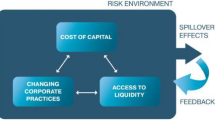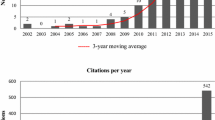Abstract
Financial access, or the household use of formal financial services, includes the ability to access transaction, credit, and investment products and services from formal financial institutions. In contrast, households that use Alternative Financial Services (AFS), or products and services from non-bank sources, lack full financial access and are considered financially excluded. Financial access is a necessary component of strong household financial well-being. Some researchers discuss the two as opposite sides of the same construct, or “two sides of the same coin” because they are closely related features of one idea. Using national data from the 2015 Financial Capability Study (n = 27,564), this study sought to explore the nature of the relationship between financial access and AFS use using confirmatory factor analysis. Results suggest that the two concepts are weakly and positively related, which suggests that they are not “two sides of the same coin”. The determinates of AFS use are complex, and may include social factors. A holistic approach to expanding financial access may be most effective. Policy implications are also discussed.


Similar content being viewed by others
References
Anderloni, L., Bayot, B., Bledowski, P., Iwanicz-Drozdowska, M., & Kempson, E. (2008). Financial services provision and prevention of financial exclusion. Brussels: European Commission, Directorate-General for Employment, Social Affairs and Equal Opportunities.
Antonova, V. (2013). The concepts of social inclusion and exclusion in global society: A journey within social institutions, actors and practices. Zhurnal Issledovanii Sotsialnoi Politiki = The Journal of Social Policy Studies, 11(2), 151–170.
Ardic, O., Imboden, K., & Latortue, A. (2013). Financial access 2012: Getting to a more comprehensive picture; Access to Finance Forum Reports by CGAP and its Partners (Vol. 6). Washington, DC: Consultive Group to Assist the Poor and International Financial Corporation.
Barry, B. M. (1998). Social exclusion, social isolation and the distribution of income. London: Centre for Analysis of Social Exclusion, London School of Economics.
Brevoort, K. P., Grimm, P., & Kambara, M. (2015). Data point: Credit invisibles. Washington, DC: Consumer Financial Protection Bureau.
Buckland, J. (2012). Hard choices: Financial exclusion, fringe banks, and poverty in urban Canada. Toronto: University of Toronto Press.
Bunyan, S., Collins, A., & Torrisi, G. (2016). Analysing household and intra-urban variants in the consumption of financial services: Uncovering “exclusion” in an English city. Journal of Consumer Policy, 39(2), 199–221. doi:10.1007/s10603-016-9319-7.
Cities for Financial Empowerment. (2017a). Bank on account national standards. New York: Author.
Cities for Financial Empowerment. (2017b). Bank on coalition statement of principles. New York: Author.
Cities for Financial Empowerment. (2017c). Projects. New York: Author. Retrieved from http://cfefund.org/projects/.
Cnaan, R. A., Moodithaya, M., & Handy, F. (2012). Financial inclusion: Lessons from rural south India’. Journal of Social Policy, 41(1), 183–205. doi:10.1017/S0047279411000377.
Collard, S., Kempson, E., & Whyley, C. (2001). Tackling financial exclusion: An area-based approach. Bristol: Policy Press.
Connolly, C. (2012). Measuring financial exclusion in Australia. Chippendale: Centre for Social Impact: University of New South Wales for National Australia Bank.
Consumer Financial Protection Bureau. (2013). CFPB study of overdraft programs. Washington, DC: Author. Retrieved from http://files.consumerfinance.gov/f/201306_cfpb_whitepaper_overdraft-practices.pdf.
Consumer Financial Protection Bureau. (2015). Financial well-being: The goal of financial education. Washington, DC: Author. Retrieved from http://files.consumerfinance.gov/f/201501_cfpb_report_financial-well-being.pdf.
Consumer Financial Protection Bureau. (2016). CFPB finalizes strong federal protections for prepaid account consumers. Washington, DC: Author. Retrieved from https://www.consumerfinance.gov/about-us/newsroom/cfpb-finalizes-strong-federal-protections-prepaid-account-consumers/.
Council of Economic Advisors. (2016). Financial inclusion in the United States. Washington, DC: Author. Retrieved from https://obamawhitehouse.archives.gov/sites/default/files/docs/20160610_financial_inclusion_cea_issue_brief.pdf.
de la Cuesta González, M., Paz-Curbera, C. R., & Olit, B. F. (2016). Banking system and financial exclusion: Towards a more comprehensive approach. In S. C. Valverde, P. J. C. Solas, & F. R. Fernandez (Eds.), Liquidity risk, efficiency and new bank business models (pp. 127–161). New York: Springer.
Despard, M., & Friedline, T. (2017). Do metropolitan areas have equal access to banking? A geographic investigation of financial services availability. Lawrence, KS: University of Kansas, Center on Assets, Education, and Inclusion (AEDI).
Despard, M., Friedline, T., & Refior, K. (2017). Can post offices increase access to financial services? A geographic investigation of financial services availability. Lawrence, KS: University of Kansas, Center on Assets, Education, and Inclusion (AEDI).
Devlin, J. F. (2005). A detailed study of financial exclusion in the UK. Journal of Consumer Policy, 28(1), 75–108. doi:10.1007/s10603-004-7313-y.
Federal Deposit Insurance Corporation. (2016). 2015 FDIC national survey of unbanked and underbanked households. Washington, DC: Author.
Fernández-Olit, B., Paredes-Gázquez, J. D., & de la Cuesta-González, M. (2017). Are social and financial exclusion two sides of the same coin? An analysis of the financial integration of vulnerable people. Social Indicators Research. doi:10.1007/s11205-016-1479-y.
FINRA Investor Education Foundation. (2016). Financial capability in the United States 2016. Washington, DC: Author.
Friedline, T. (2016). Building bridges, removing barriers: The unacceptable state of households’ financial health and how financial inclusion can help. Lawrence, KS: University of Kansas Center on Assets, Education, and Inclusion (AEDI).
Friedline, T., Despard, M., & West, S. (2017a). Investing in the future: A geographic investigation of brick-and-mortar financial services and households’ financial health. Lawrence, KS: University of Kansas Center on Assets, Education, and Inclusion (AEDI).
Friedline, T., Despard, M., & West, S. (2017b). Navigating day-to-day finances: A geographic investigation of brick-and-mortar financial services and households’ financial health. Lawrence, KS: University of Kansas, Center on Assets, Education, and Inclusion (AEDI).
Gloukoviezoff, G. (2007). From financial exclusion to overindebtedness: The paradox of difficulties for people on low incomes? In L. Anderloni, M. D. Braga, & E. M. Carluccio (Eds.), New frontiers in banking services: Emerging needs and tailored products for untapped markets (pp. 213–245). Berlin: Springer.
Goedecke, J., Guérin, I., D’espallier, B., & Venkatasubramanian, G. (2016). Why do financial inclusion policies fail in mobilizing savings from the poor? Lessons from rural South India. Development Policy Review. doi:10.1111/dpr.12272.
Gómez-Barroso, J. L., & Marbán-Flores, R. (2013). Basic financial services: A new service of general economic interest? Journal of European Social Policy, 23(3), 332–339. doi:10.1177/0958928712471226.
Gutman, A., Garon, T., Hogarth, J., & Schneider, R. (2015). Understanding and improving consumer financial health in America. Chicago, IL: Center for Financial Services Innovation.
Karp, N., & Nash-Stacey, B. W. (2015). Technology, opportunity & access: Understanding financial inclusion in the U.S. Working Paper No 15/25. United State: BBVA Research. Retrieved from https://www.bbvaresearch.com/wp-content/uploads/2015/07/WP15-25_FinancialInclusion_MSA.pdf.
Kempson, E., Atkinson, A., & Pilley, O. (2004). Policy level response to financial exclusion in developed economies: Lessons for developing countries. Report of Personal Finance Research Centre, University of Bristol. Bristol England: Personal Finance Research Centre.
Kempson, E., Crame, M., & Finney, A. (2007). Financial services provision and prevention of financial exclusion. Eurobarometer Report. Bristol, England: University of Bristol.
Kempson, E., & Whyley, C. (1999). Kept out or opted out? Understanding and combating financial exclusion. Bristol: The Policy Press.
Kempson, E., Whyley, E., Caskey, J., & Collard, S. (2000). In or out? Financial exclusion: A literature and research review. London: Financial Services Authority.
Krumer-Nevo, M., Gorodzeisky, A., & Saar-Heiman, Y. (2016). Debt, poverty, and financial exclusion. Journal of Social Work. doi:10.1177/1468017316649330.
Kumar, D. (2016). Social and economic exclusion among social groups in India. Journal of Exclusion Studies, 6(2), 148–161.
Lamb, L. (2016). Financial exclusion and financial capabilities in Canada. Journal of Financial Economic Policy, 8(2), 212–227. doi:10.1108/JFEP-06-2015-0037.
Levitas, R., Pantazis, C., Fahmy, E., Gordon, D., Lloyd, E., & Patsios, D. (2007). The multi-dimensional analysis of social exclusion. Bristol: University of Bristol.
Leyshon, A., & Thrift, N. (1995). Geographies of financial exclusion: Financial abandonment in Britain and the United States. Transactions of the Institute of British Geographers. doi:10.2307/622654.
Leyshon, A., & Thrift, N. (1996). Financial exclusion and the shifting boundaries of the financial system. Environment and Planning, 5(28), 1150–1156. doi:10.1068/a281150.
Makesh, K., & Kuzhuvelil, M. K. (2014). Financial inclusion: A literature on its causes and effects. International Journal of Applied Financial Management Perspectives, 3(1), 745–750.
Marron, D. (2013). Governing poverty in a neoliberal age: New labour and the case of financial exclusion. New Political Economy, 18(6), 785–810. doi:10.1080/13563467.2012.753043.
Marshall, J. N. (2004). Financial institutions in disadvantaged areas: A comparative analysis of policies encouraging financial inclusion in Britain and the United States. Environment and Planning A, 36(2), 241–261.
Morduch, J., Orgden, T., & Schneider, R. (2014). An invisible finance sector: How households use financial tools of their own making. Washington, DC: US Financial Diaries.
Muthén, B. O. (1984). A general structural equation model with dichotomous, ordered categorical, and continuous latent variable indicators. Psychometrika, 49(1), 115–132. doi:10.1007/BF02294210.
Muthén, L. K., & Muthén, B. O. (1998-2015). Mplus user’s guide (7th ed.). Los Angeles, CA: Muthén and Muthén.
Northwood, J. M., & Rhine, S. L. W. (2016). Use of bank and nonbank financial services: Financial decision making by immigrants and native born. Paper presented at the FDIC 6th Annual Consumer Research Symposium, Washington, DC.
Office of the Inspector General United States Postal Service. (2014). Providing non-bank financial services for the underserved. Washington, DC: Author.
Okello Candiya Bongomin, G., Ntayi, J. M., Ntayi, J. M., Munene, J. C., Munene, J. C., et al. (2016). Social capital: Mediator of financial literacy and financial inclusion in rural Uganda. Review of International Business and Strategy, 26(2), 291–312.
Rao, S., & Malapit, H. J. L. (2015). Gender, household structure and financial participation in the United States. Journal of Family and Economic Issues, 36(4), 606–620.
Ratha, D. (2006). Economic implications of remittances and migration. In 2nd international conference on migrant remittances, 13 November. London, England. Retrieved from http://siteresources.worldbank.org/INTTOPCONF3/Resources/1588024-1163704792404/S2_P1_RATHA.pdf.
Sain, M. R. M., Rahman, M. M., & Khanam, R. (2016). Financial exclusion in Australia: Can Islamic finance minimise the problem? Australasian Accounting, Business and Finance Journal, 10(3), 89–104. doi:10.1017/S0047279415000677.
Salignac, F., Muir, K., & Wong, J. (2016). Are you really financial excluded if you choose not to be included? Insights from social exclusion. Journal of Social Policy, 45(2), 269–286. doi:10.1017/S0047279415000677.
Sampson, E. L., Dover, D., Mandell, M., Pant, A., & Blanchard, M. R. (2007). Personal identification (PIN) numbers: A new cause of financial exclusion in older people. International Journal of Geriatric Psychiatry, 22(5), 492–493. doi:10.1002/gps.1708.
Schenk, M. (2012). Commerical banks and credit unions: Facts, fallacies, and recent trends. Washington, DC: Credit Union National Association.
Servon, L. (2017). The unbanking of America: How the new middle class survives. New York: Houghton Mifflin Harcourt.
Sherraden, M. (1991). Assets and the poor: A new American welfare policy. Armonk, NY: M. E. Sharpe.
Silver, H. (2010). Understanding social inclusion and its meaning for Australia. Australian Journal of Social Issues, 45(2), 183–211. doi:10.1002/j.1839-4655.2010.tb00174.x.
Simmons, L. (2017). Economic justice. In C. Franklin (Ed.), Encyclopedia of social work (pp. online). New York: National Association of Social Workers. doi:10.1093/acrefore/9780199975839.013.1266.
Simmons, L., & Harding, S. (2013). Economic justice, labor and community practice. New York: Routledge.
Sinclair, S. (2001). Financial exclusion: An introductory survey. Heriot Watt University, Edinburgh. Retrieved from https://www.academia.edu/7086629/Financial_Exclusion_An_Introductory_Survey.
Social and Enterprise Development Innovations (SEDI). (2005). Why financial capability matters: Synthesis report on Canadians and their money. Ottawa: Policy Research Initiative.
The World Bank. (2012). Financial inclusion strategies reference framework. Retrieved from http://documents.worldbank.org/curated/en/801151468152092070/pdf/787610WP0P144500use0only0900A9RD899.pdf.
The World Bank. (2015). How to measure financial inclusion. Retrieved from http://www.worldbank.org/en/topic/financialinclusion/brief/how-to-measure-financial-inclusion.
The World Bank. (2016). UFA2020 overview: Universal financial access by 2020. Retrieved from http://www.worldbank.org/en/topic/financialinclusion/brief/achieving-universal-financial-access-by-2020.
The World Bank. (2017a). Financial inclusion: Overview. Retrieved from http://www.worldbank.org/en/topic/financialinclusion/overview.
The World Bank. (2017b). Global findex. Retrieved from http://www.worldbank.org/en/programs/globalfindex.
The World Bank. (2017c). Overview: National financial inclusion strategies. Retrieved from http://www.worldbank.org/en/topic/financialinclusion/brief/national-financial-inclusion-strategies.
Theodos, B., Simms, M., Treskon, M., Stacy, C., Brash, R., Emam, D., et al. (2015). An evaluation of the impacts and implementation approaches of financial coaching programs. Washington, DC: Urban Institute.
U. S. Department of the Treasury. (2001). The report of the Native American Lending Study: Community Development Financial Institutions Fund. Washington, DC: Author.
World Bank Group. (2016). Enhancing financial capability and inclusion in Azerbaijan: A demand-side assessment. Washington, DC: International Bank for Reconstruction and Development/The World Bank Group.
Yoshino, N., & Morgan, P. (2016). Overview of financial inclusion, regulation, and education. Tokyo: Asian Development Bank Institute.
Author information
Authors and Affiliations
Corresponding author
Rights and permissions
About this article
Cite this article
Birkenmaier, J., Fu, Q. Household Financial Access and Use of Alternative Financial Services in the U.S.: Two Sides of the Same Coin?. Soc Indic Res 139, 1169–1185 (2018). https://doi.org/10.1007/s11205-017-1770-6
Accepted:
Published:
Issue Date:
DOI: https://doi.org/10.1007/s11205-017-1770-6




